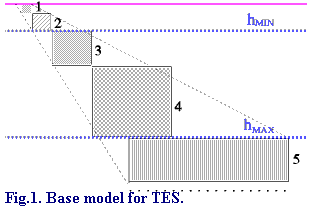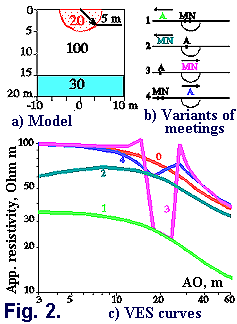 The
old base model for VES data interpretation was horizontally-layered medium.
We consider as the new base model (fig.1) a combination of
horizontally-layered structure (HLS), deep inhomogeneities (DI)
(3-4 on fig.1) and nearsurface inhomogeneities - NSI (1-2
on fig.1).
The
old base model for VES data interpretation was horizontally-layered medium.
We consider as the new base model (fig.1) a combination of
horizontally-layered structure (HLS), deep inhomogeneities (DI)
(3-4 on fig.1) and nearsurface inhomogeneities - NSI (1-2
on fig.1).
In each case the TES field technology aims to investigate a depth interval from hmin up to hmax. The horizontal size of any object to be visible should be approximately equal or more of its depth (3-4 on fig.1). The step on profile for detailed investigation of such object should be 2-5 times smaller than its size. The object laying deeper than hmax (5 on fig.1) is not visible due to restricted penetration depth. All objects at the depth smaller than hmin (1-2 on fig.1) - may influence and the more noticeably, the smaller their depth is, because they are closer to the current and potential electrodes position. But step on profile and minimal AO distance are not enough for their study. These objects are considered as geological noise.
 Difference
between NSI and deep objects depends on our selection. Some bodies in definite
depth interval we consider as useful objects and adjust field technology
for their tracing, while some others on smaller depth we consider as noise.
Distortions of the electric field (or VES curves), caused by such NSI objects
may be divided into two principal types: caused by object near dipole element
of array and caused by object near single electrode. These effects depends
also on the fact: is this dipole group or single electrode moveable or
unmoveable. These effects are shown on fig.2. Model is represented with
single NSI of half-spherical form over two-layered medium (fig.2,a). Pole-dipole
array can be applied in two ways: single electrode is moveable while dipole
group is stable or dipole group is moveable while single electrode is stable.
Stable electrode or dipole group can be placed in NSI limits (cases 1 and
2) or out of it (cases 3 and 4). In the last case moving electrode or dipole
group will cross the NSI.
Difference
between NSI and deep objects depends on our selection. Some bodies in definite
depth interval we consider as useful objects and adjust field technology
for their tracing, while some others on smaller depth we consider as noise.
Distortions of the electric field (or VES curves), caused by such NSI objects
may be divided into two principal types: caused by object near dipole element
of array and caused by object near single electrode. These effects depends
also on the fact: is this dipole group or single electrode moveable or
unmoveable. These effects are shown on fig.2. Model is represented with
single NSI of half-spherical form over two-layered medium (fig.2,a). Pole-dipole
array can be applied in two ways: single electrode is moveable while dipole
group is stable or dipole group is moveable while single electrode is stable.
Stable electrode or dipole group can be placed in NSI limits (cases 1 and
2) or out of it (cases 3 and 4). In the last case moving electrode or dipole
group will cross the NSI.
Our standard technology is two-sided pole-dipole sounding with stable MN group and moveable current electrode. For this case we use more local terms to classify distortions: P and C - effects.